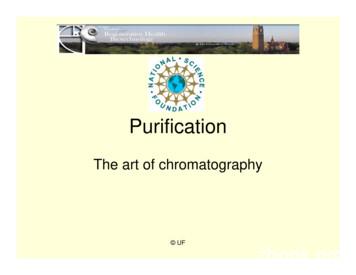GFP Purification Procedures - University Of Florida
PurificationThe art of chromatography UF
Purify a single recombinant protein of interest fromover 4,000 naturally occurringE. coli gene products. UF
Column Chromatography A separation method in which differentcomponents of a mixture travel throughthe resin of a column differently. UF
Protein purification is based onchemical properties Proteins can be separated based on:– Size– Charge (ion exchange) Cation Exchanger (anions on resin bind positively chargedprotein) Anion Exchanger (Cations on resin bind negatively chargedprotein)– Specific binding affinity (resin coupled w/antibodyspecific to protein of interest)– Hydrophobicity (Hydrophobic Interaction Column). UF
Hydrophobic Interaction Hydrophobic (water hating) substances donot mix well with water Some amino acids of proteins are veryhydrophobic In salt water, these parts of the proteinstick tightly to other hydrophobicsubstances (causes conformationalchange so hydrophilic regions areprotected). UF
HIC Column Hydrophobic amino acids of protein bind toa support (gel matrix) in the column, whichcontains immobilized hydrophobic groups(phenyl).Hydrophobicbead UF
Step 1:Hydrophobic InteractionChromatography Add bacteriallysate tocolumn matrixin high saltbuffer– Hydrophobicproteinsinteract withcolumn UFhttp://www.bio-rad.com/LifeScience/docs/Official pGLO GFP powerpoint Spring 2005.ppt
Step 2:Hydrophobic InteractionChromatography Wash lesshydrophobicfrom columnwith low saltbuffer– LesshydrophobicE. coliproteins fallfrom column– GFP remainsbound to thecolumn UFhttp://www.bio-rad.com/LifeScience/docs/Official pGLO GFP powerpoint Spring 2005.ppt
Step 3:Hydrophobic InteractionChromatography Elute GFPfrom columnby adding nosalt bufferGFP– Releasedfrom columnmatrix– Flows throughthe column UFhttp://www.bio-rad.com/LifeScience/docs/Official pGLO GFP powerpoint Spring 2005.ppt
BiopharmaceuticalManufacturing Controlled ptic Product––––SafePurePotentStableCenter of Excellence for Regenerative Health UFBiotechnology
Protein 02229AD.pdf UF
rs/contract/neo/ UF
Center of Excellence for Regenerative Health Biotechnology UF
Chromatogram f
Purityhttp://www.genedetect.com/rave.htm UF
Process Development1. Identification of target proteinw/therapeutic value2. Identification of target gene3. Isolation of the target gene4. Insertion of the target gene into a hostcell (such as E.coli) & express protein5. Purification: Separation of the targetprotein from the host cell protein UF
Process Development cont.6. Large scale production of the targetprotein (under controlled manufacturingconditions)7. Formulate8. Testing for safety and efficacy9. Marketing of a new medicine UF
GFP Purification ProceduresDay 1Day 2 UFDay 3http://www.bio-rad.com/LifeScience/docs/Official pGLO GFP powerpoint Spring 2005.ppt
Hydrophobic InteractionChromatography:Steps 1–31.Add bacterial lysate to column matrix inhigh salt buffer2.Wash less hydrophobic proteins fromcolumn in low salt buffer3.Elute GFP from column withno salt buffer UF
UFhttp://www.bio-rad.com/LifeScience/docs/Official pGLO GFP powerpoint Spring 2005.ppt
Helpful Hints:Hydrophobic InteractionChromatography Add a small piece ofpaper to collection tubewhere column seats toinsure column flow Rest pipette tip on sideof column to avoidcolumn bed disturbancewhen adding solutions Drain until the meniscus isjust above the matrix forbest separation UFhttp://www.bio-rad.com/LifeScience/docs/Official pGLO GFP powerpoint Spring 2005.ppt
This material is based upon work supported by the National ScienceFoundation under Grant No. 0438229.Any opinions, findings, and conclusions or recommendationsexpressed in this material are those of the author(s) and do notnecessarily reflect the views of the National Science Foundation. UF
Process Development 1. Identification of target protein w/therapeutic value 2. Identification of target gene 3. Isolation of the target gene 4. Insertion of the target gene into a host cell (such as E.coli) & express protein 5. Purification: Separation of the target protein from the host cell protein
1. Access the Procurement Toolbox GFP Conversion Tool 2. Browse to the saved GFP Excel Template 3. Enter your email address 4. Click “Convert GFP Attachment” 5. Receive notice of “processing upload” and then that Attachment is “being converted” 6. Receive email with URL to fetch PDF GFP Attachment 7. Click URL and download PDF 8.
GNb allow specific labelling of a variety of RFP and GFP variants in live cells. Targeting sensors to RFP and GFP The effects of intracellular messengers such as Ca2 [27], H [28]andATP/ADP[29] can be highly localized within cells. To enable visualization of these intracellular messen-gers in microdomains around RFP-tagged and GFP-tagged
individual purification methods based solely on their purification factor. Context is paramount. It is impossible to predict what combination of separation methods will work best for a given virus purification process, and how many steps will be required to achieve the degree of purification required to support a particular application. Development
innovation since the late 1970s. Our research scale purification instruments are the most technologically advanced and effective purification systems available. Our method development and purification algorithms help scientists convert traditional regular flash purification to faster, greener, and more economical processes for reliably isolating
Therefore elution conditions must be optimized for each protein. An easy way to opti-mize conditions is to use an imidazole gradient for elution, rather than a single imidazole concentration. Protocol The following purification protocol is optimized for purification of His 6-tagged GFP. If it
Many enzyme purification methods have been developed over the years. Traditional purification procedures make use of the physicochemical properties of the enzyme of . is referred to the "Guide to Protein Purification" in Methods in Enzymology 463 [10]. Adrie H. Westphal 1 and Willem J. H. van Berkel1,2 1 Wageningen University & Research .
Magnetic beads for DNA purification 9 Genomic DNA purification kits 10 Genomic DNA extraction 16 Genotyping—pharmacogenomics studies 17 Plant genomic DNA isolation kits 18 Viral genomic DNA purification kits 20 Genomic DNA from saliva 21 Complete purification system for nucleic acids
Introduction to Qualitative Field Research 3 01-Bailey-(V-5).qxd 8/14/2006 6:24 PM Page 3. He observed, interviewed, and took photographs of them, even one of “Primo feeding cocaine to Caesar on the benches of a housing project courtyard” (p. 101). Purpose of Research and Research Questions Although all field research takes place within natural settings, it serves different purposes. It is .























